The EEGLAB News #3
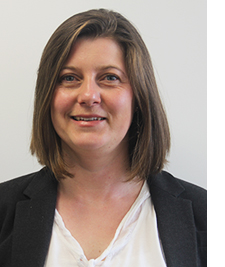 Elizabeth Milne, Ph.D.
Elizabeth Milne, Ph.D.
Professor of Cognitive Neuroscience, Department of Psychology, The University of Sheffield, UK
“While presenting a poster at a conference, a visitor tactfully mentioned that I could glean greater insights from my EEG data if I used more advanced analysis methods,” Professor Elizabeth Milne recalls. “He mentioned EEGLAB and research at the Swartz Center for Cognitive Neuroscience (SCCN). I downloaded EEGLAB as soon as I got back to my hotel room, and I’ve never looked back."
 Professor Milne is describing a fortuitous exchange at the annual meeting of the International Society for Autism Research in 2006 that forever changed the way she analyzes her research data. As Professor of Cognitive Neuroscience at the University of Sheffield in South Yorkshire, England, Professor Milne studies how individual differences in neural oscillations are related to individual differences in human behavior and cognition. A main focus (among many) is on understanding neurodevelopmental conditions such as autism.
Professor Milne is describing a fortuitous exchange at the annual meeting of the International Society for Autism Research in 2006 that forever changed the way she analyzes her research data. As Professor of Cognitive Neuroscience at the University of Sheffield in South Yorkshire, England, Professor Milne studies how individual differences in neural oscillations are related to individual differences in human behavior and cognition. A main focus (among many) is on understanding neurodevelopmental conditions such as autism.
Professor Milne explains how studying EEG can add insight into the field: “Autism is defined as a neurodevelopmental condition; however, the neurological basis of autism remains elusive. In the past, I have been motivated to carry out work that aimed at identifying aspects of the EEG signal that may differentiate individuals with and without autism. This type of work speaks to research on neurological biomarkers for autism, and leads to greater understanding of the neurological basis for particular experiences in autism, such as heightened sensory sensitivity.”
But the more work Professor Milne has performed in the field, the more convinced she becomes that “what we currently term as autism most likely represents a constellation of distinct subtypes with distinct neural etiologies and different experiences.” She admits that “this point has been made by Geneticists for a while now, but work in neuroscience is only just catching up. Therefore, my more recent work is aimed at understanding the spectrum of autism, specifically in relation to heterogeneity within the condition, and considering trans-diagnostic features, such as increased neural variability, which occur in autism as well as other neurodevelopmental conditions.”
Since learning about EEGLAB, she uses the toolbox routinely in her research. “I’m a big fan of the ICA approach, i.e. analyzing data in source-space rather than sensor-space,” she clarifies. “Although it takes time to do this type of analysis well and to identify the resultant components, this approach highlights the wealth of information embedded within EEG data and provides a lens that enables researchers to make new discoveries within their data. I find this particularly valuable in my work on autism, where even small variations between individuals can be the key to gaining a greater understanding of brain and behavior relationships.”
FROM THE BEGINNING
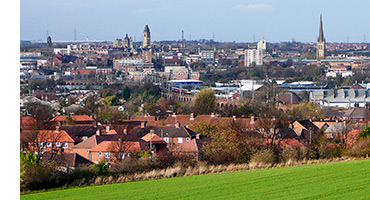 Professor Milne has been interested in Psychology for as long as she can remember. Growing up in Wakefield, a small industrial city in Yorkshire, England, she has vivid memories of “creating questionnaires for my family to fill in, and then spending ages drawing graphs to show the ‘results’.” When she discovered the field of neuroscience while at Oxford University, she became fascinated by the interplay between brain and behavior. She delved deeper into the field, receiving a bachelor’s degree in experimental psychology from Oxford in 1998, and then a Ph.D. in psychology at University College London (UCL) in 2004.
Professor Milne has been interested in Psychology for as long as she can remember. Growing up in Wakefield, a small industrial city in Yorkshire, England, she has vivid memories of “creating questionnaires for my family to fill in, and then spending ages drawing graphs to show the ‘results’.” When she discovered the field of neuroscience while at Oxford University, she became fascinated by the interplay between brain and behavior. She delved deeper into the field, receiving a bachelor’s degree in experimental psychology from Oxford in 1998, and then a Ph.D. in psychology at University College London (UCL) in 2004.
SWARTZ CENTER FOR COGNITIVE NEUROSCIENCE (SCCN)
After Professor Milne’s first exposure to SCCN at the conference in 2006, she become captivated by EEGLAB and began paying close attention to the EEGLAB mailing list.
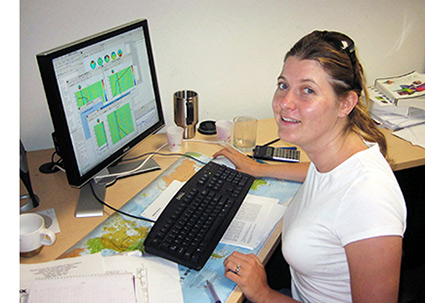 “One evening as I was reading through the messages on the mailing list,” she recollects, “I noticed that Dr. Makeig had advertised a post-doctoral position that would involve carrying out work aimed at investigating attentional processes in autism.”
“One evening as I was reading through the messages on the mailing list,” she recollects, “I noticed that Dr. Makeig had advertised a post-doctoral position that would involve carrying out work aimed at investigating attentional processes in autism.”
The project sounded fascinating and was just the type of role that Professor Milne would enjoy. However, she wasn’t in a position to apply for the job, as she already had a faculty position at the University of Sheffield. But she realized this was a golden opportunity and didn’t give up. “I e-mailed Scott Makeig to express my interest, and to ask whether it might be possible to come and join him on this project as a visiting scientist, if I were able to secure a sabbatical from my position in Sheffield.” Luckily, the head of her department in Sheffield at the time was very supportive. “After sending off my CV and having a telephone interview with Scott Makeig and Julie Onton, I found myself making plans to work at SCCN in the summer of 2007.” (Photo: Professor Milne working at her desk at SCCN)
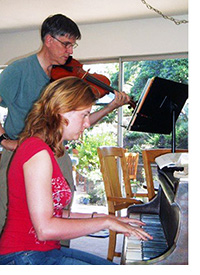 Professor Milne found SCCN to be a very stimulating place. “I enjoyed working alongside people from different academic disciplines and with different areas of expertise.” One project entailed developing a paradigm that could be used to measure attention switching in autistic children. This involved displaying animations on a display screen, and synchronizing eye-tracking with EEG acquisition. “This was before the development of Lab Streaming Layer (a software framework for synchronizing data collection and stimulation devices), so at the time was quite a technical challenge. I also worked on analyzing data that I had previously collected from children with and without autism.” (Photo at left: Playing music together - Dr. Makeig on violin and Professor Milne on piano).
Professor Milne found SCCN to be a very stimulating place. “I enjoyed working alongside people from different academic disciplines and with different areas of expertise.” One project entailed developing a paradigm that could be used to measure attention switching in autistic children. This involved displaying animations on a display screen, and synchronizing eye-tracking with EEG acquisition. “This was before the development of Lab Streaming Layer (a software framework for synchronizing data collection and stimulation devices), so at the time was quite a technical challenge. I also worked on analyzing data that I had previously collected from children with and without autism.” (Photo at left: Playing music together - Dr. Makeig on violin and Professor Milne on piano).
While her project was challenging, it proved very rewarding. “I worked hard to learn as much as I could during my time there,” she recalls. “Scott, Arnaud, and many other members of the group were very generous with their time, and tolerant of my many questions. I developed skills and expertise during this time that I still use in my current research, and share with my own students.”
EEGLAB AND PORTABLE EEG SYSTEMS
Another aspect of EEGLAB that Professor Milne finds helpful is "the drive and motivation of the developers and those who work with them, to continuously provide new tools that increase the capacity of what EEG researchers can do." She continues, "For example, in my work on autism, it is important to be able to reach a range of participants, including those who typically may not usually be able to take part in research studies due to the severity of their symptoms or anxiety associated with visiting a new and unfamiliar environment. Using portable EEG systems allows me to take my research out of the lab and to record data in more naturalistic settings. This opens up a way to answer many currently unexplored questions, but also enables data collection to take place somewhere where participants feel more comfortable – improving access to research for people who may not typically be included in neuroimaging studies of autism."
During a project recently carried out by her Ph.D. student, Aikaterini Giannadou, they have found the Lab Streaming Layer to be invaluable in enabling them to synchronise stimulation and recording equipment, and have just completed a study in which EEG data were collected from children with and without autism in the comfort of their own homes. "We are now in the process of analysing these data," she adds, "to identify whether similar neural signals are seen in all of the participants, or whether different types of behaviour are associated with distinct neural differences."
EEGLAB WORKSHOP
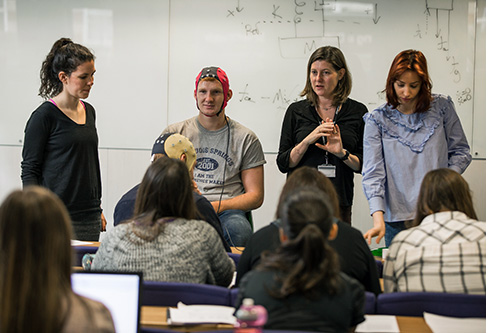 In addition to aiding in her own research, Professor Milne finds EEGLAB invaluable as a teaching resource. “One of the aspects that I enjoy most about my current job is training students to use EEGLAB, including adapting the scripts for their own use, in order to help them learn more about the brain, about EEG, and about signal processing.” (Photo: Professor Milne teaches third year undergraduate students about EEG).
In addition to aiding in her own research, Professor Milne finds EEGLAB invaluable as a teaching resource. “One of the aspects that I enjoy most about my current job is training students to use EEGLAB, including adapting the scripts for their own use, in order to help them learn more about the brain, about EEG, and about signal processing.” (Photo: Professor Milne teaches third year undergraduate students about EEG).
Professor Milne has become such a fan of EEGLAB that she hosted an EEGLAB workshop in Sheffield, UK – the Twentieth EEGLAB Workshop (September 2-5, 2015). She explains the life circumstances that helped in her decision to organize the event: “I now have two children, so travelling abroad to conferences or to visit collaborators is more complicated than it used to be. Hosting an EEGLAB workshop in Sheffield was a great way to bring EEG scientists together, to re-connect with collaborators and meet new colleagues, without having to be too far away from home.”
There is another force at play. After making so many wonderful connections during her time at SCCN – on both a professional and personal level – she is intent on keeping up with SCCN news. She explains, “The workshop provided a great opportunity to hear about how SCCN had evolved since I had visited, where the technical developments had taken the research and which research questions members of the group were currently focusing on. Hosting a workshop in Sheffield also provided my students with an opportunity to learn about EEGLAB from the people who developed it, and to meet Scott and some of the members of his group. I was also glad of the opportunity to show Scott some of the same hospitality in Sheffield that he extended to me while I was in San Diego.”
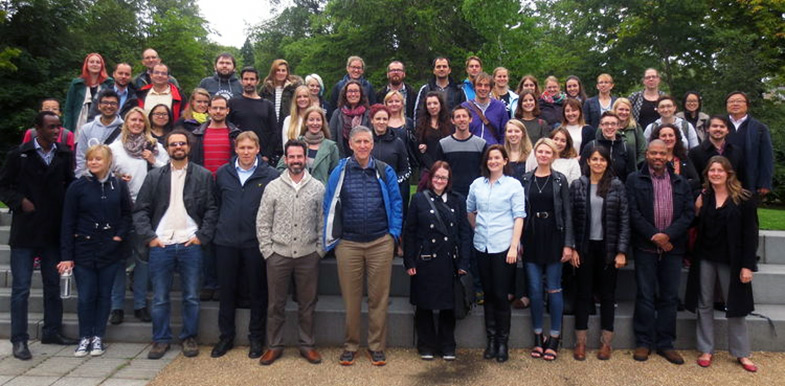
The Twentieth EEGLAB Workshop in Sheffield, UK (September 2-5, 2015)
THE POWER OF DAILY TEA
Professor Milne’s visit to SCCN has had a powerful impact on her life and research. "As you can probably tell from my responses," she added, "I really enjoyed my time in SCCN. The visitor to my poster had been correct – I did discover much more from my data by applying some of the tools being developed by SCCN! For example, by adopting a single-trial approach to the data, I discovered greater trial-to-trial variability in evoked responses in individuals with autism, a finding which has now been replicated by other groups around the world.”
“More than this though,” she says, pausing for emphasis, “I found the atmosphere of the SCCN lab to be stimulating and engaging, and I especially enjoyed the daily ‘tea’ where members of the lab sat down together, drank tea and talked about science – amongst other things. I try to model this with my own research group. No matter how busy you are, it’s important to take time out to talk with your colleagues, and encourage others to share their expertise. This really maximizes the productivity of the group, and enables the whole to be greater than the sum of the parts, something which I think is exemplified by SCCN.”
R. Weistrop, January 2020
References:
Milne, E., Scope, A., Pascalis, O., Buckley, D. and Makeig, S., 2009. Independent component analysis reveals atypical electroencephalographic activity during visual perception in individuals with autism. Biological psychiatry, 65(1), pp.22-30. [133 Google Scholar citations]
Milne, E., 2011. Increased intra-participant variability in children with autistic spectrum disorders: evidence from single-trial analysis of evoked EEG. Frontiers in psychology, 2, p.51. [142 citations]
David, N., Schneider, T.R., Peiker, I., Al-Jawahiri, R., Engel, A.K. and Milne, E., 2016. Variability of cortical oscillation patterns: A possible endophenotype in autism spectrum disorders?. Neuroscience & Biobehavioral Reviews, 71, pp.590-600. [26 citations]
Denis, D., Rowe, R., Williams, A.M. and Milne, E., 2017. The role of cortical sensorimotor oscillations in action anticipation. Neuroimage, 146, pp.1102-1114. [29 citations]
Milne, E., Gomez, R., Giannadou, A. and Jones, M., 2019. Atypical EEG in autism spectrum disorder: Comparing a dimensional and a categorical approach. Journal of abnormal psychology, 128(5), p.442.
Milne, E., Dunn, S., Zhao, C. and Jones, M., 2019. Altered neural dynamics in people who report spontaneous out of body experiences. Cortex, 111, pp.87-99.